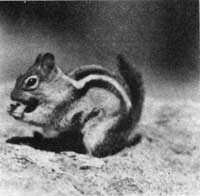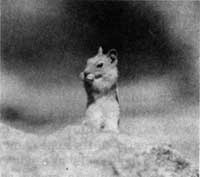|
THE GOLDEN MANTLED
GROUND SQUIRREL
by Ralph R. Huestis
Special Number - 1951
The Golden-Mantled Ground Squirrel In Crater Lake National Park
By Ralph R. Huestis
The golden-mantled ground squirrel, Citellus lateralis
chrysodeirus Merriam, is one of the commonest mammals in Crater Lake
National Park and probably produces more entertainment for visitors than
all other types combined. This is not only because these animals are
aggregated along the rim and in the campgrounds, where the greatest
concentration of visitors takes place, but also because the squirrels
are handsome in appearance, readily conditioned to the presence of human
beings, and both appealing and comical in their behavior.
This species is commonly present in forested regions of Oregon from
the Cascade mountains eastward and is especially prevalent in the
ponderosa pine forests of the Cascade, Blue, and Wallowa Mountains. It
is found, in these regions, from the edge of the sagebrush up into the
white-bark pines at 8000 feet altitude. At Crater Lake these squirrels
are present in all regions of the park including both Wizard Island and,
on one occasion, on the Phantom Ship. The race occupying the Siskiyou
mountains and therefore present in the Oregon Caves National Monument is
described as subspecifically distinct and called the tawney-mantled
ground squirrel, Citellus lateralis trinitatus Merriam.
DESCRIPTION
The golden-mantled ground squirrel is a chunky little animal with a
body about seven inches long and a well furred tail somewhat more than
one-half the body length. Its legs are rather short and its ears
relatively small but held tautly erect. The eyes are quite large for a
burrowing animal and their size, combined with the erect carriage of the
ears, give these squirrels an air of alertness and intelligence.
The flanks, the underside of the tail, and the head and shoulders
are colored a rich, reddish brown. This is the coloring that accounts
for the name golden-mantled. The back carries a broad median gray
stripe, on each side of which are narrower contrasted stripes of black
and white; two black ones with a white stripe between them. These
contrasted stripes following the curve of the back while the squirrel
sits up add greatly to its appearance.

". . . contrasted stripes following the curve of the
back . . ."
|
Ground squirrels are not very fast animals and this squirrel
compares unfavorably in speed with the chipmunks that occupy the same
territory and with small enemy carnivores like the Cascade weasel, the
Pacific marten, and the Cascade red fox. There is, however, an alertness
in its postures and a briskness and energy in its movements that
visitors find attractive. It seems probable that the hurried gallop from
point to point which the squirrels alternate with a frozen pose or a
brief nosing of the ground is highly adaptive. An animal in motion is
likely to be seen and had better hurry if it moves at all. In addition,
the time spent on exposed territory and between feeding periods is
reduced to a minimum. These points may not be obvious to visitors, but
they do see a hard-working little animal and admire the display of
energy.
Comedy is supplied by the fact that the air of brisk alertness is
not accompanied by any real evidence of great intelligence. In fact
Citellus not infrequently plays the role of a busy fool;
searching industriously for peanuts in empty hands when full ones
beckon, and taking the trouble to investigate with a passing sniff any
little object which may lie in his pathway on the rim walk pavement. He
easily changes, too, from assured approach to precipitous flight with
his tail above his back at about the angle a stove lifter projects from
the lid, his broad little hams twinkling as his short hind legs spurn
the dust.

"Comedy is supplied by the air of brisk alertness . . ."
|
Golden-mantled ground squirrels are said by Vernon Bailey to have
but one brood a year of four to six or more young. Grinnell found an
average of five young in five females in Yosemite National Park. The
number probably increases with the age of the mother and as fully adult
females have ten functional mammae they could easily accommodate larger
broods. In 1936 a mother squirrel was observed moving nine little ones
from a burrow in the rim campground and in 1938 the accidental death of
a mother squirrel was followed by the exit of eight hungry little
squirrels which were adopted and fed by rim campground visitors. Young
are reported by Vernon Bailey to be born late in June or early in July.
This checks with observations at Crater Lake National Park where in both
1937 and 1938 young squirrels emerged from burrows along the rim during
the first week in August. The adopted brood mentioned in the previous
paragraph seemed to be about three weeks old on August the eighth. A
small newly-emerged squirrel was seen coming out of a burrow in the rim
campground as late as September 3, 1937.

". . . searching industriously for peanuts . . ."
|
The episode mentioned above in which a mother squirrel moved young
from a burrow, part of which had been collapsed by a car, shows that
these animals share the typical mammalian habit of moving young to less
menaced positions. In August 1938 Dr. Fred Miller, park physician,
observed the moving of six young from a nest somewhere in the Community
House through the door to a refuge somewhere outside the building. The
young were carried by the body with ventral surface toward the mother's
mouth and curled around the mother's head just as young deer mice are
under similar circumstances.
| 
